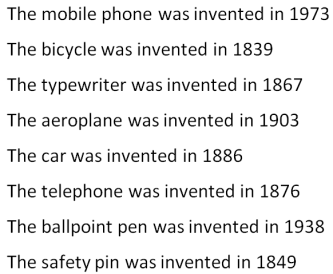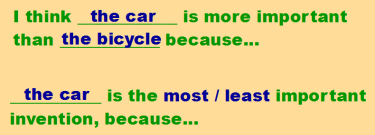My Primary students (aged 11) are studying technology and inventions at the moment. I used this activity to introduce the topic – it worked well. This idea could be used for generating interest, sharing personal responses, developing schematic knowledge, revising comparatives, developing spoken fluency, and much more… It’s amazing what a few images can too – it’s fairly low-prep.
- Students work in pairs or groups. Give each group some images of inventions (like above). Do a ‘name the invention’ mini whiteboard challenge, or some variation. Use word scrambles for support (e.g. theelonep = telephone). Check and drill the invention names
- Instruct students to put the images in order – which was invented first?
Give them process language to help, e.g.
A: I think _______________ was invented before ____________
B: I agree / maybe / hmmm, I’m not sure. I think….
Etc.
- Once students decide the order, instruct them to guess the year… mine struggled with this, but I allowed them 50 years +/- to encourage them! This ended up going to 100 years +/- actually!
- Students do a running dictation in pairs to get the answers.
5. Check student guesses, award points for the correct order or correct years. Students then arrange the images into the correct order.
6. Use the order to play a memory game. Demo the following:
The bicycle was invented before the safety pin.
The safety pin was invented before the typewriter.
The typewriter was invented before the….
Ask different students to continue the sequence. Once complete, instruct groups to remove one or two images from their order….e.g. ’take away the car and the telephone’. Go through the sequence again, awarding points to students who remember missing items. Repeat until students remember the whole sequence without any images! Five minutes of fun!
- Develop a pyramid style discussion based on the inventions. First students work alone. They write the inventions in their notebook in order of importance, and make notes to support their views. Model this a bit yourself on the board
Next, students share their ideas with a partner. They re-order the pictures on their table depending on their views, but they must agree on the new order. Again, process language will be needed here:
Students then work with another pair (in a group of 4). They compare ideas/orders, discuss and reorder the pictures again to represent the views of the whole group.
- Send one member of each group to another table (I’ve heard this activity called ‘spies’ or ‘envoys’ before..?). The group explain their views to the ‘spy’ from another group. The ‘spy’ then returns to their own group members, reporting back on the opinions from the other group. Finally, each group decides if any final changes should be made to their own order of inventions. End with class feedback/discussion.
In practice… how did this work?
- I did this with two different groups. Given the level and age of my students, I thought they managed loads of speaking and could express their views really well. More process/task language was needed for the pyramid discussion stage – I reviewed some more simple ways to agree and disagree
- The final discussion extended a bit, thanks to one student pointing out that some inventions were very important in the past but not so much now. He prompted us to discuss which invention was the most important – they settled on the telephone because without it we might not have developed mobile phones! I probably should have thought about the whole ‘is/was important’ thing when planning, but I’m glad I didn’t as that student showed some nice higher-order thinking!
- My students are on the cusp of our Secondary level, and overall they are pretty strong speakers. They did really well, but this type of thing was quite demanding for them. Still, why not challenge them? Expect some funny answers for the ‘guess the year’ bit though!
For another idea for introducing inventions, click here
I mentioned a technique for drilling vocabulary in this other post
Categories: Lesson Ideas, other




Leave a comment